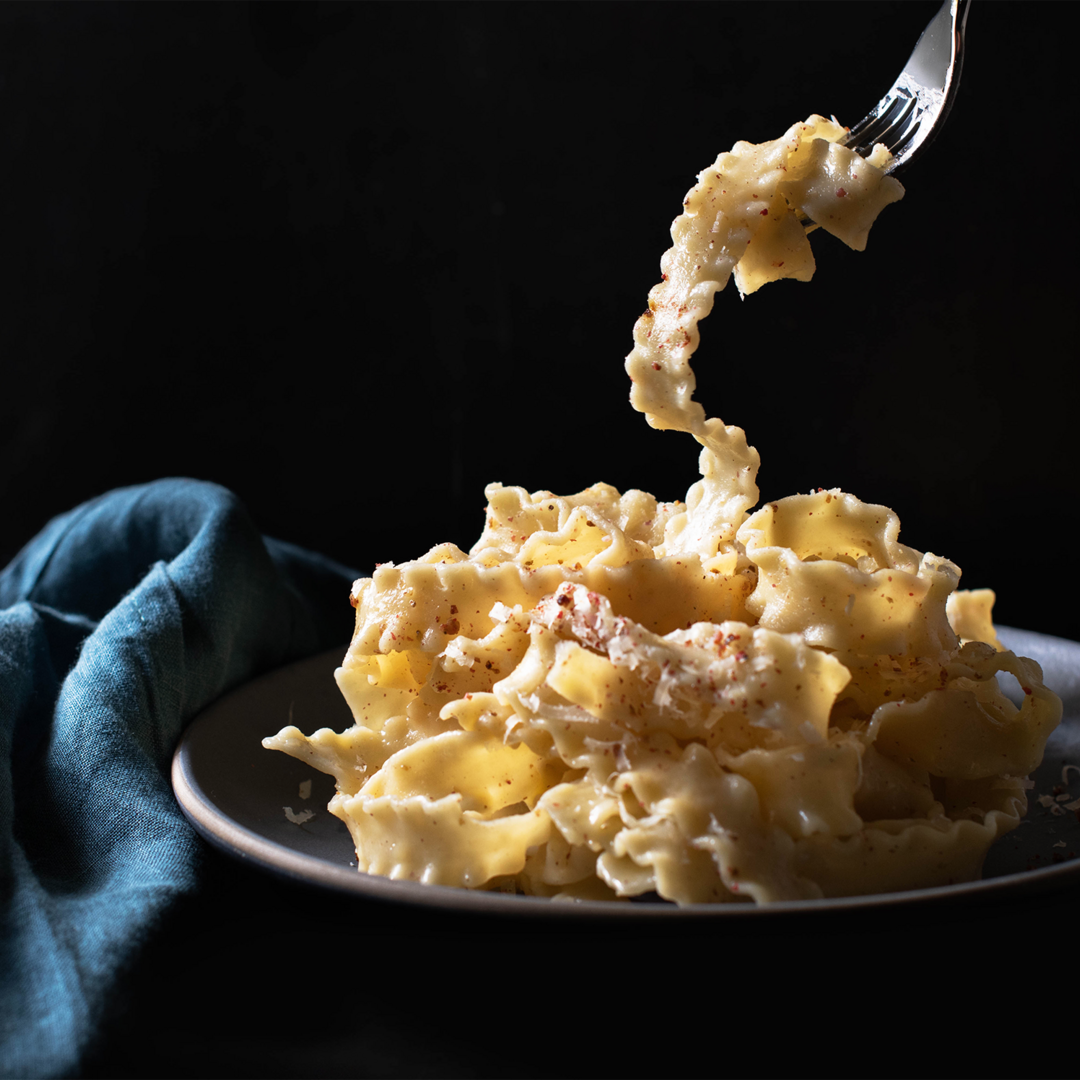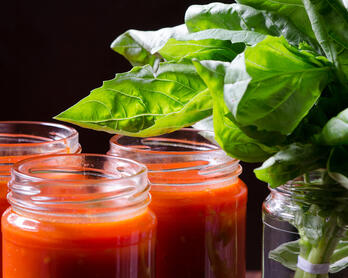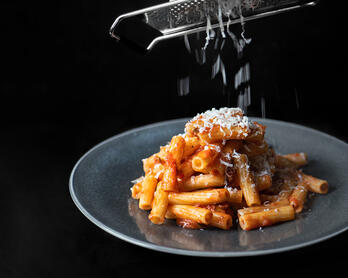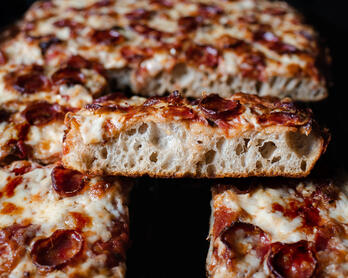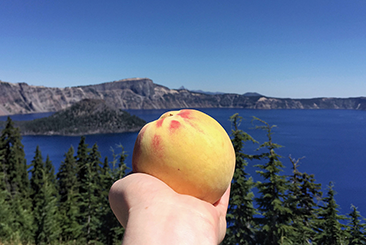Lilia's Mafaldine with Pink Peppercorns
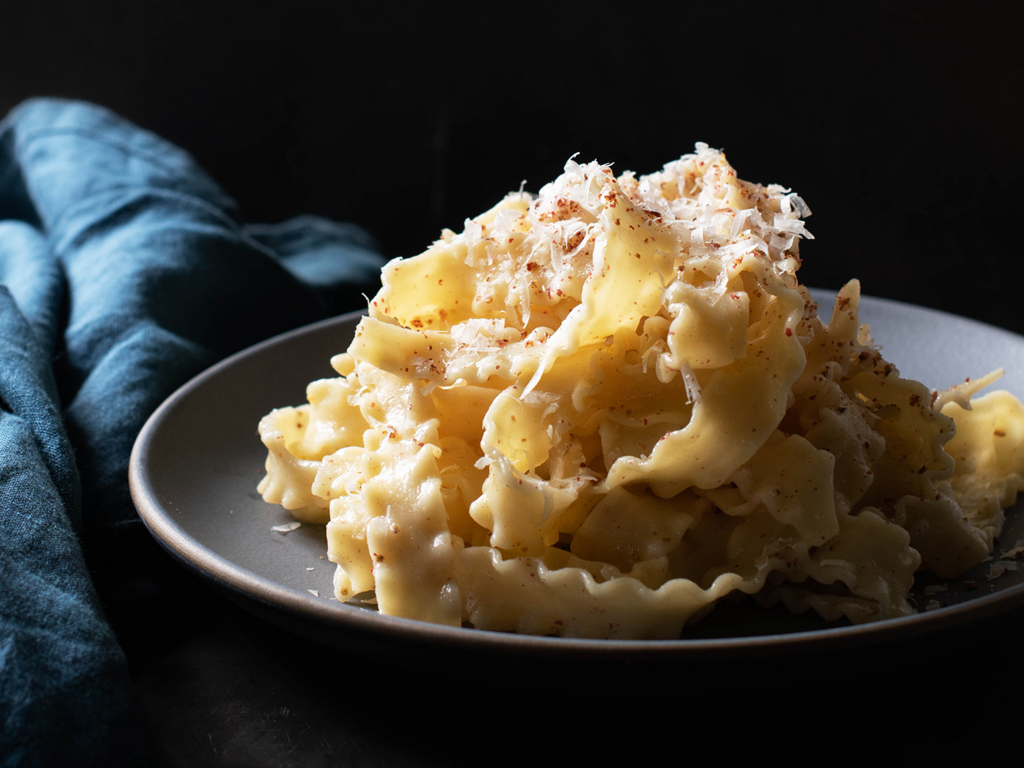
I miss warm nights and cool wine at Lilia's in Brooklyn and often have a taste for their Mafaldine Pasta with Pink Peppercorns. The dish is essentially cacio e pepe with pink peppercorns in lieu of black pepper, the bright and fruity spice of the pink berries perfectly complimenting the umami-rich cheese. I usually serve the pasta with a simple salad and find the meal is a satisfying fallback when I don't know what else to make.
The following recipe is lightly adapted from Chef Missy Robbins' version that is scattered around the Internet. There are only 5 ingredients but quality products and a little technique go a long way. The mafaldine I use isn’t homemade and though that can be a significant difference in a spare dish, it's not a deal breaker. I’m not ready to invest in an extruder (yet), but Lilia's hypnotic scratch noodle videos certainly tempt me. This West Coast rendition tastes pretty close to my flavor memory plus it's quick and comforting so you can't go wrong.
Don't let the length of this post throw you, I went off on a cheese tangent. The instructions to make the pasta are relatively short.
Around the Dinner Table
From curry to pecorino, my American understanding of food is often oversimplified. Pecorino is an example of a cheese that is far more dynamic than I realized before becoming a more serious cook.
For a recipe that only has 5 ingredients like Mafaldine with Pink Peppercorns, the type and quality of cheese you use can be impactful. Below is a bit of what I have learned about pecorino which is half of the cheese duo in the dish. I also include a section about Parmigiano Reggiano because the queen of cheese must never be ignored.
Pecorino Basics
- Milk - Pecorino means "of sheep" and there are several types of Italian sheep's-milk cheese. Examples include Pecorino Romano, Pecorino Sardo (Dolce or Maturo/Young or Aged), and Pecorino Toscano.
- DOP - Cheeses such as Pecorino Romano are legally protected in name and process. This is known as DOP or Protected Designation of Origin. For example, anything called Pecorino Romano or Pecorino Toscano must be produced and packaged in a specific manner and place to use the name.
- Age - Pecorino gets sharper, more aromatic, and firmer the older it is. Very generally speaking, you want a mature pecorino such as Pecorino Romano or Pecorino Sardo Maturo for grating and finishing a pasta dish. Young pecorino such as Pecorino Toscano Fresco (fresh) is described as having a more mild and almost sweet flavor. Young pecorino can be used as a table cheese - serve it with figs, cheese, or a salad.
Is Romano the same as Pecorino Romano?
It is not, but I for one would not have known that several years back. As this Cook's Illustrated article puts it:
Domestic cheeses labeled "Romano" are an entirely different breed of cheese than Italian imports bearing the name "Pecorino Romano".
Cheeses labeled as simply Romano are generally made with cow's milk rather than sheep's milk. As noted above, pecorino is made of sheep's milk which gives the cheese a sharper, funkier, and more nuanced flavor profile. Different isn't bad, but true pecorino is preferable when it comes to spare dishes like cacio e pepe or Mafaldine with Pink Peppercorns.
In This Dish
I usually have Pecorino Romano or Pecorino Sardo Maturo (mature) on hand since those are some of the cheeses I use when finishing pasta dishes and pizza. I recall using Fiore Sardo once so that could be another option.
On that note, some websites suggest Pecorino Sardo Maturo is the same as Fiore Sardo. After the Internet insisted on confusing me (as it does), I called Santa Monica's Italian importer, Guidi Marcello. The folks there said the cheeses are very similar - age, sheep's milk, flavor - but are not the same.
Parmigiano Reggiano Basics
- Milk - Parmigiano Reggiano is made from cow's milk. Historically speaking, Parmigiano's "mother cow" is the red cow known as Vacche Rosse or La Razza Reggiana. The Vacche Rosse fell out of favor due to its low milk production and almost went extinct in the 20th century. Thankfully, there has been a resurgence so if you find Red Cow Parmigiano Reggiano, it's thanks to this beautiful breed.
- DOP - Like Pecorino Romano, Parmigiano Reggiano is legally protected in name and process. This is known as DOP or Protected Designation of Origin. The cheese must be produced and packaged in a specific manner and place.
- Age - Parmigiano Reggiano has to be aged a minimum of 12 months and becomes dryer and more complex the older it gets.
Is Parmesan the same as Parmigiano Reggiano?
Similar to Romano vs. Pecorino Romano, the answer is no. Parmigiano Reggiano is a DOP product (Protected Designation of Origin) and the real deal cannot be beat.
In This Dish
- For Mafaldine with Pink Peppercorns and most cooking, I use a 3-year Parmigiano Reggiano from Guido Marcello in Santa Monica. It has a nice level of saltiness and intensity. Most of what is found in grocery stores is 18 to 24 months and that will also work.
Recipe Tips
I Heart Sodium
When first making Lilia's Mafaldine with Pink Peppercorns, I found myself wanting to add too much salt at the end which is a harsh way to finish any dish. The solution was to layer the seasoning by using salted butter and substituting some pecorino for the parmesan - that did the trick. Only a pinch of salt should be needed at the end if any.
Finesse
When finishing the pasta in the butter sauce and prior to adding the cheese, don't cook the noodles until the pan is dry. If you think you’re almost done, that’s when you’re actually done. The cheese will tighten up the sauce considerably so it's better to have a little too much moisture than too little.
Keep It Fancy
Though spaghetti certainly works, mafaldine gives things a fancy edge (literally and figuratively). What would otherwise look a bit plain is something special with all of those ruffled edges plus the mouthfeel is great.
Salty Starch
There is a step in the process where you scoop out a cup of salted pasta cooking water. The purpose of this is three-fold and applies to many pasta dishes.
- The salted water helps season the butter sauce.
- Starchy water creates a clingy sauce.
- You want some of the cooking water on hand if the sauce needs a bit of additional thinning.
In The Mood
If you're in the mood for cacio e pepe, you can swap black pepper in for the pink peppercorns and spaghetti for the mafaldine without any other changes.
Tools
- Spice Grinder - Grinding whole spices offers a big flavor payoff for relatively little effort. This grinder gets the job done and is easy to clean and store. I use it more often than I ever expected.
- Scale - I weigh everything and my OXO scale is the workhorse of the kitchen. My current scale that I purchased many years ago has a black pull-out display. The updated model is all stainless steel but seems to be the same otherwise.
- Coarse Grater - I originally owned a few Microplane graters with plastic around the edge that ended up cracking. I switched to stainless steel and haven't had any issues since. I own the fine, coarse, and extra coarse graters. For this dish, I opt for the coarse grater.
Ingredients
- 16 ounces mafaldine pasta (spaghetti can be substituted)
- 7 tablespoons quality salted butter
- 3 teaspoons coarsely ground pink peppercorns, divided (measured after processing in a spice grinder) Note: I really like the flavor of pink peppercorns and sometimes add a smidge more when serving.
- 1 1/4 ounces freshly grated Pecorino Romano or Pecorino Sardo Maturo Note: See Around the Dinner Table above for expanded cheese notes.
- 1 1/4 ounces freshly grated Parmigiano Reggiano, plus extra for finishing as desired
- 4-6 ounces (1/2-3/4 cup) starchy cooking water
Instructions
- Place oven-safe individual pasta bowls in a cold oven then heat to 175°F. This is a fussy step but it makes a difference in terms of the serving temperature. The cheesy butter sauce is its best self when warm.
- While the water is coming to a boil, prep the other ingredients.
- Once at a boil, salt the pasta water generously with kosher salt - it should taste salty but not quite "like the sea" (I don't go that far). Add the pasta to the boiling water.
- While the pasta cooks, put the butter in a large nonstick pan and heat over medium-low. Keep an eye on the butter and make sure it only melts and doesn’t brown.
- Cook the pasta until it’s just shy of al dente. There’s a little more cooking that takes place in the butter sauce.
- A minute before the pasta is done, ladle 1/2 cup of the salted pasta water into the pan with the melted butter and adjust the heat to medium-high (don't let the butter brown). Ladle another 1/2 cup of pasta cooking water out and set aside. That is your thinning water.
- Transfer the pasta directly from the salty water into the pan with the butter mixture and, over medium-high heat, toss repeatedly until the sauce begins to thicken and the noodles finish cooking. This takes 1-2 minutes. Note: You will still see quite a bit of loose liquid in the pan at first. That's good and necessary as the liquid will partially be absorbed by the noodles and anything that remains will mix with the cheese and create your clingy sauce. If the pan starts to dry up during this step, use your thinning water.
- Once the noodles are to the desired texture, adjust the heat to low and add half (1 1/2 teaspoons) of the ground pink peppercorns, half of the Pecorino Romano, and half of the Parmigiano Reggiano, then toss briskly. Add the rest of the cheese, toss, and taste for seasoning.
- Plate and top with the rest of the peppercorns plus some extra grated Parmigiano Reggiano.
Monthly Roundup
- Subscribe at the bottom of this page for the Chic Eats monthly roundup. It includes new and updated recipes along with a grab bag of content that was interesting enough to share around the dinner table.
